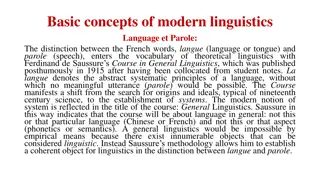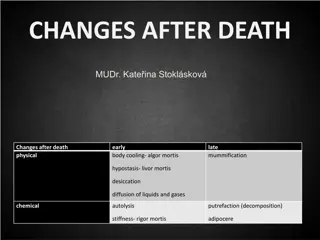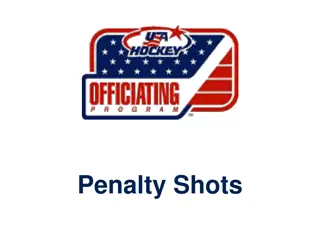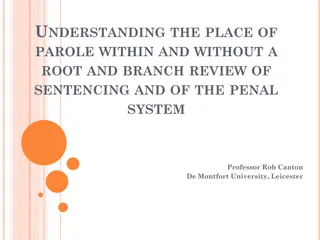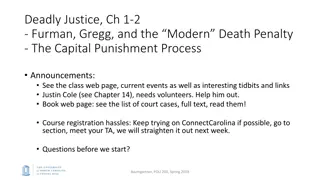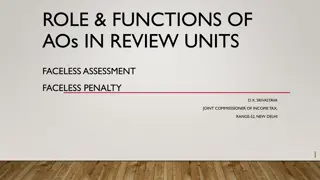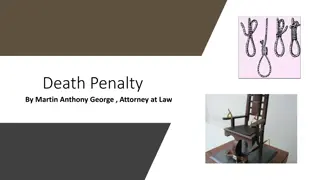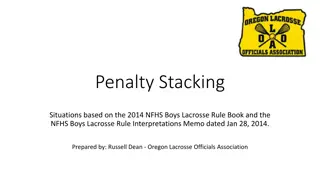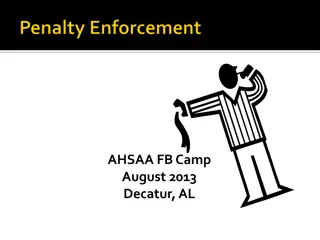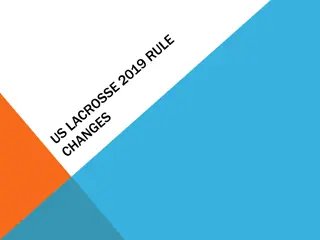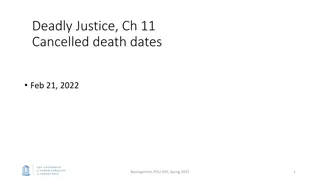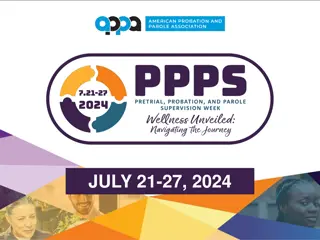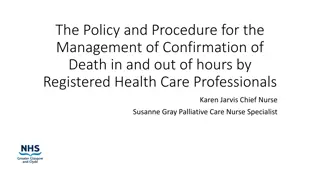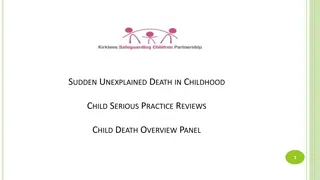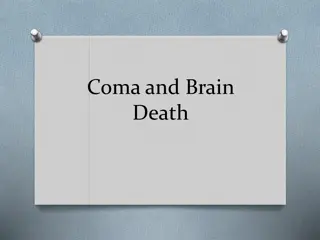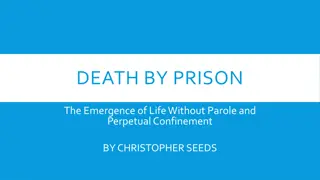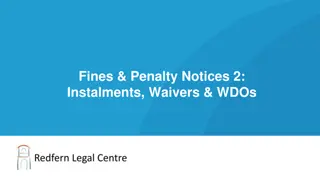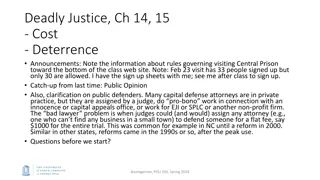Understanding Life Without Parole as an Alternative to the Death Penalty
Explore the complexities of the life without parole (LWOP) sentence as an alternative to the death penalty, touching upon topics such as racial resentment, systemic criminal behavior, the geriatric crisis in prisons, and the punishment matrix. Delve into the predictive model analyzing the use of the death penalty across states based on various factors, including population size, crime rates, racial demographics, political variables, and more. Reflect on the implications of racial resentment and ideological differences in shaping criminal justice policies.
Download Presentation

Please find below an Image/Link to download the presentation.
The content on the website is provided AS IS for your information and personal use only. It may not be sold, licensed, or shared on other websites without obtaining consent from the author. Download presentation by click this link. If you encounter any issues during the download, it is possible that the publisher has removed the file from their server.
E N D
Presentation Transcript
Life Without Parole as the alternative to the death penalty, and the implications of that Plan for the day: Finish lecture from last time concerning Racial Resentment Add a little to the discussion from last time regarding individual v. systemic understandings of criminal behavior Discuss LWOP and the paper you read about the growing geriatric crisis Discuss the punishment matrix and ask for your reactions to that April 13, 2022 POLI 203, Spring 2022 1
Racial resentment and the death penalty Article is on the class website, co-authored with PhD student Christian Caron and Sociology professor Scott Duxbury We take the 50 states and count how many death sentences are imposed each year, in each state. How can we predict / understand the relative use of the death penalty across the states? POLI 203, Spring 2022 2
The Racial Resentment Scale Do you agree strongly, agree somewhat, neither agree nor disagree, disagree somewhat, or disagree strongly with each of the following statements? (1) Irish, Italians, Jewish and many other minorities overcame prejudice and worked their way up. Blacks should do the same without any special favors. (2) Generations of slavery and discrimination have created conditions that make it difficult for blacks to work their way out of the lower class. (3) Over the past few years, blacks have gotten less than they deserve. (4) It s really a matter of some people not trying hard enough; if blacks would only try harder they could be just as well off as whites. POLI 203, Spring 2022 3
Our predictive model includes these variables Population size Homicides in the previous year Violent crime rate in the previous year Percent black in the population The history of lynchings in the state (number) Republican governor (yes / no) Republican share of the state legislature (percent) Whether they elect or appoint judges in the state Whether the state is in the south How many death sentences have been previously imposed, from 1976 to the current year (e.g., momentum) Year POLI 203, Spring 2022 4
But our model also includes these: Racial Resentment Measured by cumulative response to 4 questions previously discussed Then aggregated by year and by state. So we get an aggregate measure of racial resentment for the entire state. Lowest resentment, VT, OR, MA, RI, WA, all from the early 1990s Highest resentment, AR, WV, TN, SD, IN, ND, LA, all from later years (Resentment is generally growing over time, and it differs from state to state.) Conservative v. liberal ideology score Separately measured based on a similar method, taking huge numbers of surveys and estimating the average score on a left-right scale, for each state, year by year. (Someone else did this.) POLI 203, Spring 2022 5
What do the results show? Year: Decline over time Momentum: big effect for previous usage Elected Judges impose more No effect for partisanship of legislature or governor Violent crime, but not homicides, controlling for population size Conservative ideology: Yes Racial resentment: Yes POLI 203, Spring 2022 6
Also, an indirect effect for race and lynchings No direct effect. However, states with a history of lynchings tend to have more black population still today. These states have higher levels of racial resentment, and more conservative political ideology. We can show that that history of lynchings operates still today by exacerbating racial resentment and ideology. POLI 203, Spring 2022 7
Main effect Controlling for all those variables, including general ideological conservativism, states with higher levels of racial resentment have higher levels of use of the death penalty. Others have shown that responses to that set of questions strongly affect death penalty attitude at the individual level. (see the paper for the citations) We show that this actually affects the number of sentences imposed Pretty ugly stuff POLI 203, Spring 2022 8
Dispositional v. systemic causes of crime Let s go back to Peffley and Hurwitz for a minute General attribution of crime (appendix, p. 1009) Do you feel crime is cause more by poverty and lack of opportunity, or by people being too lazy to work for an honest living? Is it due to poverty and lack of opportunity, or because many younger people don t respect authority? POLI 203, Spring 2022 9
Why do people commit crime? They are psychopaths and evil? They are lazy and make bad choices? They are embedded in a structure that provides them no opportunities and so they are forced into bad choices? Maybe some combination of structures and individual choices? POLI 203, Spring 2022 10
Why are some people rich, or poor? They work hard / fail to work hard? They were born into a family that gave them every opportunity / born into a situation that made everything more difficult? They lived in an area with great schools, low crime, etc. / they grew up in an area with no opportunities? They inherited a trust fund / they grew up in poverty? Maybe some combination of individual and systemic causes? POLI 203, Spring 2022 11
Individual v. situational explanations We can all recognize that some successful people are successful because they worked hard. Some poor or unsuccessful people are so because they are lazy or refuse to work hard. At the same time, we can all recognize that there are situational factors as well: good schools, good opportunities, an uncle who can offer a summer job, etc. People can recognize both factors, but tend in one direction or another. POLI 203, Spring 2022 12
Liberal / conservative v. individual / situational Conservative ideology emphasizes individual choice and responsibility, matching the American dream of self-made men and self-reliance. Progressive ideology is more likely to focus on structural barriers to success for some and structural advantages for others. Neither is completely true, of course. But people can emphasize one over the other. Compared to other countries, Americans accept the individual explanation much more than others. Self-made men are the quintessential American success story. This actually has more implications than you may have realized, since it implies that the failed person failed by lack of effort. POLI 203, Spring 2022 13
Crime and other outcomes People s attribution of crime, poverty, or success to either the individual s own poor (good) choices v. to structural or systemic causes determines their idea of the proper response to it. Individualistic causes of crime: Harsher punishment Individualistic causes of wealth: low taxes, no redistribution to the poor, since the poor are poor because of their own choices. Systemic causes of crime, or poverty: It s hard to support harsh punishments, if the person did not choose that path in life, but had it given to them. This is a good way to understand people s ideology: Just ask them a few questions about why are the rich rich and the poor poor. POLI 203, Spring 2022 14
A coming geriatric crisis in prison, and other implications of LWOP Paper with Lyle May, your own TA Alex Love, and several students still enrolled here at UNC and Duke (Robertson scholars). Basic idea: Policymakers went crazy in the 1980s and 1990s with competing on who could be tougher on crime than the other Implications of this: extremely harsh punishments 30-40 years later, those 20-somethings will be 60-somethings POLI 203, Spring 2022 15
Part 1, why did they get so harsh on crime? Dehumanization Super-predator myth See the 10 minute NYT Video on this toward the bottom of the class website (Resources related to juvenile LWOP ) This is exactly what Chris Turner got caught up in; urban kids wilding Irredeemability Part of the myth above was that these kids can never be made alright Another part was a 1974 article by Martinson, assessing prison rehab programs. In both cases, academic research saying exactly what policymakers wanted to hear was over-interpreted and promoted as if it were true. POLI 203, Spring 2022 16
Part 2, how harsh did we get? Every single state adopted LWOP by about 2005. Particularly steep movement, from 20 to 40 states, in just a few years around 1994. Over 30 states adopted some form of 3-strikes law, around that same time. NC: 1994 sentencing reform produced the punishment matrix you read. Truth in punishment . POLI 203, Spring 2022 17
Part 3, the obvious, but delayed, consequences. People still go into prison at about the same ages. Many people leave. But a small share never leave. They just grow older and older, and the following year, another cohort joins them. We re just beginning to see the consequences of this and it will continue to explode in the next decades. POLI 203, Spring 2022 18
The death penalty and LWOP The creation of LWOP actually promoted the decline of the death penalty, since it made the alternative to death be so severe that many people are willing to accept it. But which punishment is really worse? The death penalty anchors the punishment system at the high end. It makes other extreme punishments seem reasonable or lighter or less severe when in fact these are very extreme punishments. So this is another indirect effect of the death penalty, and of American exceptionalism. POLI 203, Spring 2022 19





